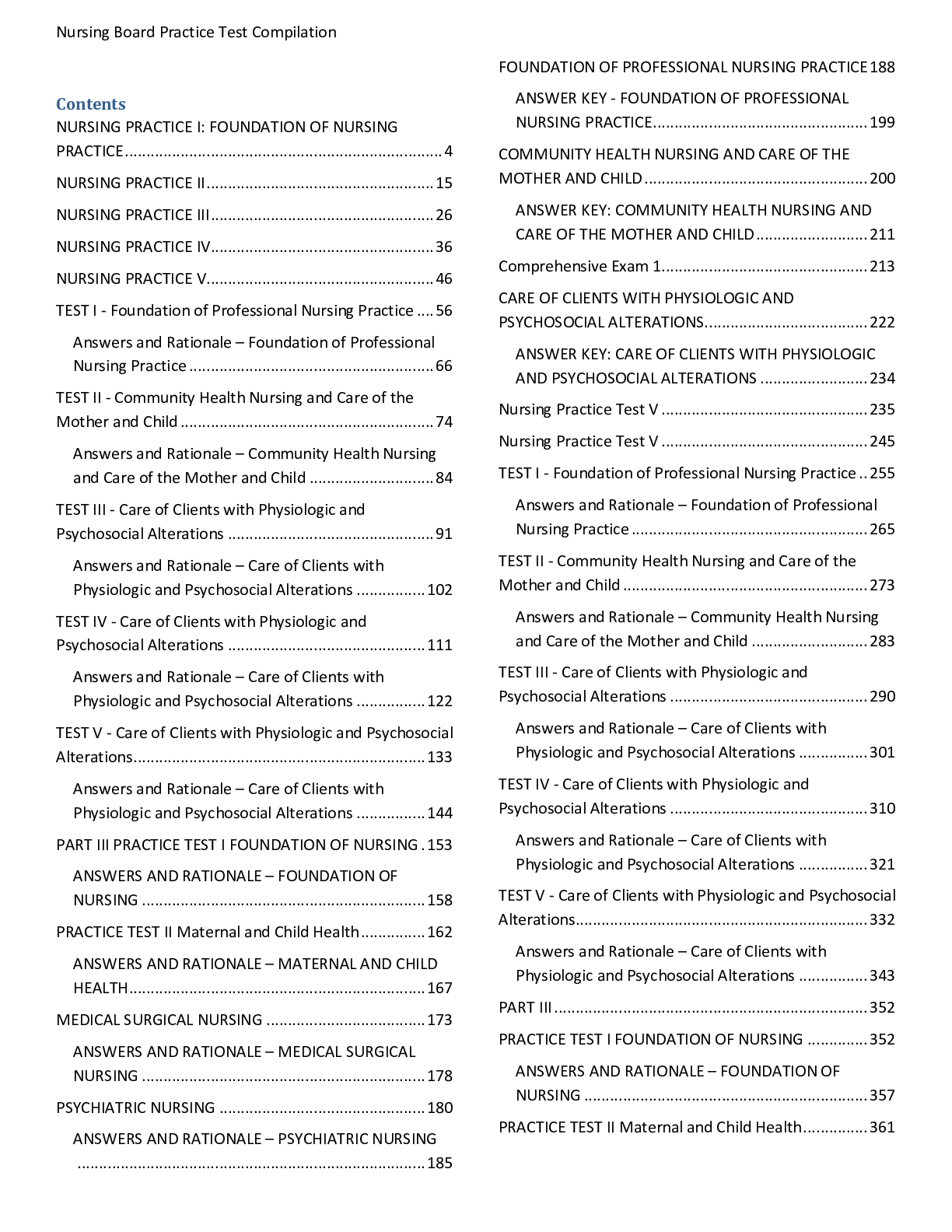Pathophysiology > EXAM > NURS 231 Pathophysiology All Module Exams Questions And Answers Questions And Answers( Complete Solu (All)
NURS 231 Pathophysiology All Module Exams Questions And Answers Questions And Answers( Complete Solution)/.Rated A+
Document Content and Description Below
NURS 231 Pathophysiology All Module Exams Module 1 Exam Question 1 2.5 / 2.5 pts True/False: A bodybuilder’s muscles will display hyperplasia. True Correct! False It will display hyper trophy. Quest... ion 2 2.5 / 2.5 pts True/False: Barrett esophagus is an example of dysplasia. True Correct! False It’s metaplasia. Question 3 0 / 2.5 pts True/False: Hypertrophy is an increase in the size of an organ or tissue caused by an increase in the number of cells You Answered True Correct Answer False Question 4 2.5 / 2.5 pts True/False: Hypertrophy can occur under normal and pathological conditions. Correct! True False Question 5 10 / 10 pts Match the following: Deals with the cause of death in a population a. Incidence Number of new cases in a population at risk during a specified time b. Prevalence Number of people with the disease in a population in a given time c. Morbidity The effect of an illness on one’s life d. Mortality Question 6 2.5 / 2.5 pts Multiple Choice Which is NOT true of the cytoskeleton? It controls shape and movement Cilia and flagella are microtubule-filled cellular extensions Correct! It includes peroxisomes and proteasomes Peroxisomes and proteasomes are not part of the cytoskeleton. Question 7 1.67 / 2.5 pts Which of the following move across the cell membrane via diffusion? Select all that apply. Correct! Oxygen Glucose Correct Answer Water Correct! Carbon dioxide Question 8 2.5 / 2.5 pts Multiple Choice Which of the following are false regarding cell communication? Endocrine signaling depends on hormones Neurotransmitters act through synapses G-protein linked receptors act through an on-off switch Correct! Paracrine signaling releases a chemical into the extracellular fluid that affects its own activity Question 9 2.5 / 2.5 pts Which is true of the cytoskeleton? Select all that apply. Correct! It controls shape and movement Correct! Cilia and flagella are microtubule-filled cellular extensions It includes peroxisomes and proteasomes Question 10 0 / 2.5 pts Multiple Choice High blood pressure is an example of which of the following? Pathology Correct Answer Pathophysiology Physiology You Answered No answer text provided. Question 11 2.5 / 2.5 pts Multiple Choice A patient has a fever and rash. What are these examples of? Correct! Signs Symptoms Both A & B Question 12 2.5 / 2.5 pts Multiple Choice Which of the following is true of a test’s sensitivity? It is how likely the same result will occur if repeated Correct! If negative, it can safely be assumed that the person does not have a disease It is considered a true-negative result It can only be calculated from people without the disease Question 13 2.5 / 2.5 pts Multiple Choice Which of the following is the effect of an illness on one’s life? Incidence Correct! Morbidity Prevalence Mortality Question 14 10 / 10 pts Define secondary prevention and give an example: Your Answer: It is one of three categories in disease prevention. It aims to detect and treat disease early, while the disease is asymptomatic and curable. An example is an annual Pap smear. Secondary prevention aims to detect and treat disease early, usually while the disease is asymptomatic and curable. Some examples include annual Pap smears to detect early cervical cancer, encouraging smoking cessation, checking blood pressure and cholesterol, and colonoscopy screening. Question 15 10 / 10 pts Compare and contrast the two types of gangrenous necrosis. Your Answer: 2 types are dry and moist. In dry gangrenous, the affected tissue is dehydrated, shrinks back and becomes dark brown or black in color. THe spread of dry is slow. In wet, the affected area is cold, swollen, with no pulse. The skin is moist, black, and distended. Small blisters form and as liquefaction occurs, foul ordor emerges. The spread of wet gangrenous is rapid. In dry gangrene the affected tissue becomes dry and shrinks, the skin wrinkles, and its color changes to dark brown or black. The spread of dry gangrene is slow. It results from a cut off in arterial blood supply and is a form of coagulation necrosis. In wet gangrene, the affected area is cold, swollen, and pulseless. The skin is moist, black, and under tension. Blebs form on the surface, liquefaction occurs, and a foul odor is caused by bacterial action. The spread of tissue damage is rapid. Question 16 10 / 10 pts Explain what necrosis is and give an example and description of one type of necrosis. Your Answer: Necrosis is cell death in tissue or organ that is still part of a living person. An example of a type of necrosis is coagulative necrosis. This results from a sudden cutoff of the blood supply to an organ, such as the heart. Necrosis refers to cell death in an organ or tissues that is still part of a living person. It often interferes with cell replacement and tissue regeneration. Coagulative necrosis results most often from a sudden cutoff of blood supply to an organ (ischemia), particularly the heart and kidney. Liquefactive necrosis occurs when some of the cells die but their catalytic enzymes are not destroyed. It is commonly seen with brain infarcts or abscesses. Caseous necrosis occurs as part of granulomatous inflammation and is most often associated with tuberculosis. Gangrenous necrosis most often affects the lower extremities or bowel and is secondary to vascular occlusion. The term gangrene is applied when a considerable mass of tissue undergoes necrosis. In dry gangrene the affected tissue becomes dry and shrinks, the skin wrinkles, and its color changes to dark brown or black. The spread of dry gangrene is slow. It results from a cut off in arterial blood supply and is a form of coagulation necrosis. In wet gangrene, the affected area is cold, swollen, and pulseless. The skin is moist, black, and under tension. Blebs form on the surface, liquefaction occurs, and a foul odor is caused by bacterial action. The spread of tissue damage is rapid. Question 17 10 / 10 pts Match the type of cell injury to the cause. Some answers may be used more than once. (1 point each) Sunburn a. Physical agents Obesity b. Radiation injury Reactive oxygen species c. Chemical injury Low oxygen to tissues d. Biologic agents Fractures e. Nutritional imbalances OTC drugs f. Free radical injury Hypothermia g. Hypoxic cell injury Radiation treatment Lead toxicity Bacteria Question 18 10 / 10 pts List the 4 types of tissue found in the body. Pick 2 and give a description and example of each. Your Answer: Epithelial, Connective, Muscle, and Nervous Epithelial tissue covers the body's outer surface, lines inner surfaces, forms glandular tissue. It is avascular and can be squamous, cuboidal, and columnar. An example of this type of tissue is our skin. Muscle tissue functions to move our bones, pump blood through the heart, as well as contract blood vessels. Cardiac muscle tissue is an example of muscle tissue. Epithelial tissue covers the body’s outer surface, lines the inner surfaces, and forms glandular tissue. Epithelial tissue has three distinct surfaces and the basal surface is attached to an underlying basement membrane. It is avascular, meaning without blood vessels. It receives oxygen and nutrients from the capillaries of the connective tissue on which it rests. Connective or supportive tissue is the most abundant tissue in the body. It connects and binds or supports the various tissues. Its cells produce the extracellular matrix that support and hold tissues together. Connective tissue is divided into two types: connective tissue proper and specialized connective tissue (cartilage, bone, and blood cells). The four types of connective tissue proper are loose (areolar), adipose, reticular, and dense connective tissue. The function of muscle tissue is to move the skeletal structures, pump blood through the heart, and contract the blood vessels and visceral organs. Muscle tissue can accomplish this by contraction. The two types of fibers that contract are called thin and thick filaments. Thin filaments are called actin, and the thick filaments are myosin. The three types of muscles tissue are skeletal, cardiac, and smooth. Nervous tissue is distributed throughout the body for communication. It provides the means for controlling body function and for sensing and moving about the environment. The two types of cells are neuron and glial cells. Neurons function is communication. Glial (meaning glue) cells support the neurons. Question 19 2.5 / 2.5 pts What is the most studied active transport system in the human body? Your Answer: The most studied active transport system is the sodium-potassium-ATPase pump. This pumo moves sodium from inside the cell to outside region, returning potassium to the inside of the cell. If this did not occur, sodium would remain in the cell, water would follow resulting in the cell to swell. Sodium-potassium (Na+/K+)-ATPase pump Question 20 2.5 / 2.5 pts What is the term to describe when cells use energy to move ions against an electrical or chemical gradient? Your Answer: Active transport Active transport Question 21 2.5 / 2.5 pts Give one function of a membrane potential: Your Answer: Generate nerve impulses Generate nerve impulse, muscle contractions, or cause hormone secretion Question 22 2.5 / 2.5 pts What is the term that describes a transport protein to help lipid soluble or large molecules pass through the membrane, that otherwise would not be able to get through? Your Answer: Facilitated diffusion facilitated diffusion Module 2 Exam- Question 1 3 / 3 pts True/False: Blood tests for tumor markers are the single best screening tool for cancer. Why or why not? Your Answer: False. Tumor markers, which can be used for establishig prognosis, monitoring treatment and detecting recurrent disease, have limitiations. Under benign situations, tumor markers can still be elevated. Whereas in early stages of malignancy, not elevated. They have a lack of specificity and are then limited in their ability to screen or diagnose accuratley. False, they are elevated in benign conditions, most are not elevated in the early stages of malignancy. Question 2 3 / 3 pts Tissue biopsy is of critical importance in what role? Your Answer: Play a critical role in histologic and cytologic studies for diagnosis of cancers. Diagnosing the correct cancer and histology. Question 3 4 / 4 pts 1. List two signs or symptoms a patient may present with that might indicate a cancer diagnosis: 2. What are two side effects commonly experienced by cancer patients? Your Answer: 1) Bleeding and/or weight loss 2) Anorexia, hair loss 1. Bleeding; sore that doesn’t heal; fluid in the pleural, pericardial, or peritoneal spaces; chest pain, shortness of breath, cough, abdominal discomfort or swelling. Other possible answers can include a mass or lump, pain (need to be specific), fatigue, fevers, weight loss 2. Weight loss, wasting of body fat and muscle tissue, weakness, anorexia, and anemia, fatigue, sleep disturbances Question 4 10 / 10 pts Explain the TNM system: Your Answer: TNM system is a detailed staging system, created by AJCC, is used by cancer facilites. It classifies cancers into stages using 3 tumor components; Tumor, Nodes, Metastasis. T is size and spread of the primary tumor. N is how involved the lymph nodes. M is the extent of metastatic involvement. Classification: Tx, T0, Tis, T1-4 Nx, N0, N1-3 Mx, M0, M1 T is the size and local spread of the primary tumor. N is the involvement of the regional lymph nodes. M is the extent of the metastatic involvement. Question 5 10 / 10 pts 1. When would surgery be appropriate in the treatment of cancer? 2. Most chemotherapeutic drugs cause pancytopenia due to bone marrow suppression. What are the 3 possible adverse outcomes of this? Your Answer: 1. Surgery can be used if the tumor is solid and small with well-defines margins. Also can be used to treat oncologic emergencies and be used as prophylactic measures. 2. 3 possible adverse outcomes are neutropenia, anemia, thrombocytopenia. 1. Surgery is often the first treatment for solid tumors. If the tumor is small with well-defined margins, it can be removed completely. It is also used for oncologic emergencies and prophylactic surgery in high risk patients. 2. Neutropenia- risk for infections Anemia- causing fatigue Thrombocytopenia- risk for bleeding Question 6 2.5 / 2.5 pts True/False: Cell proliferation is the process in which proliferating cells become more specialized cell types. True Correct! False False, cell differentiation Question 7 2.5 / 2.5 pts True/False: Cell differentiation is the process of increasing cell numbers by mitotic cell division. True Correct! False False, cell proliferation Question 8 2.5 / 2.5 pts What are two important properties that stem cells possess? Your Answer: Stem cells possess self-renewal and potency. Self renewal means that they can undergo mitotic divisions while maintaining undifferentiated state. Potency is the differentiation potential of stem cells. Potency and self-renewal Question 9 0 / 2.5 pts Which of the following are most likely to have arisen from an adult stem cell? You Answered Muscle Bone Correct Answer Epithelial Neural Question 10 4 / 4 pts What is angiogenesis? Why do tumors need it? Your Answer: Angiogenesis is the development of new blood vessels within the tumor. In order to continue growing, it must establish blood vessels and growth factors. development of new blood vessels within the tumor. They need it to continue to grow [Show More]
Last updated: 1 year ago
Preview 1 out of 73 pages
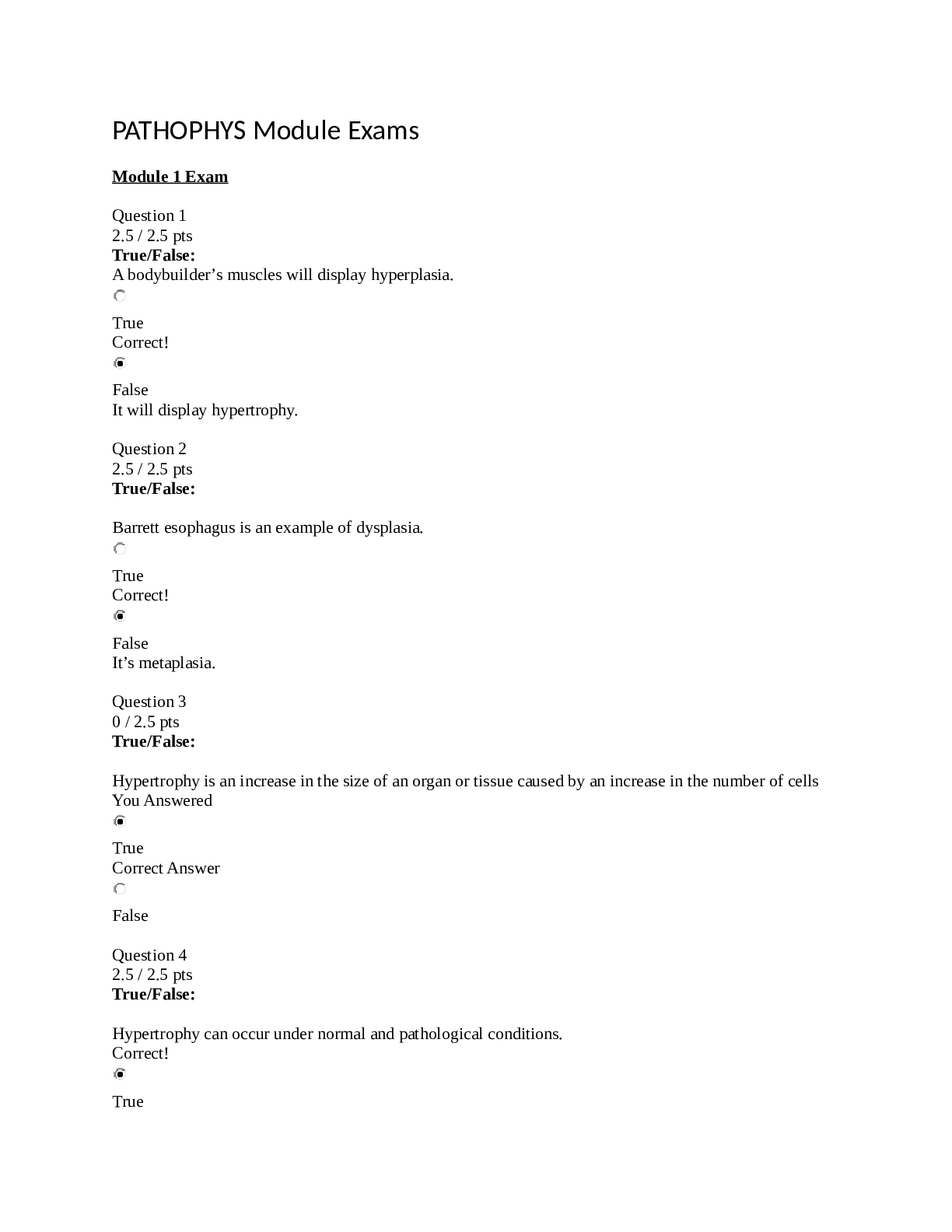
Buy this document to get the full access instantly
Instant Download Access after purchase
Add to cartInstant download
We Accept:

Reviews( 0 )
$15.50
Document information
Connected school, study & course
About the document
Uploaded On
Mar 07, 2022
Number of pages
73
Written in
Additional information
This document has been written for:
Uploaded
Mar 07, 2022
Downloads
0
Views
41

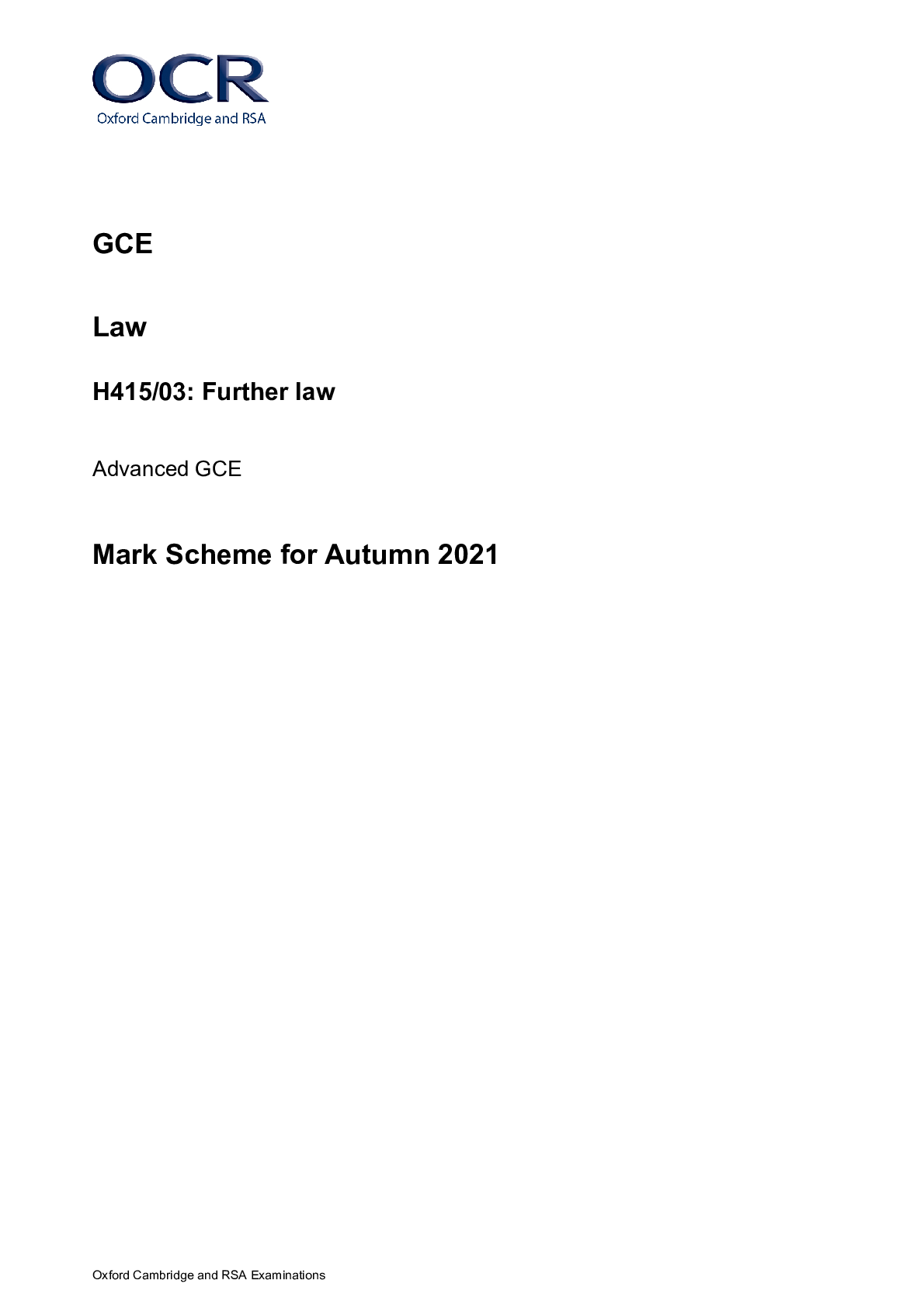
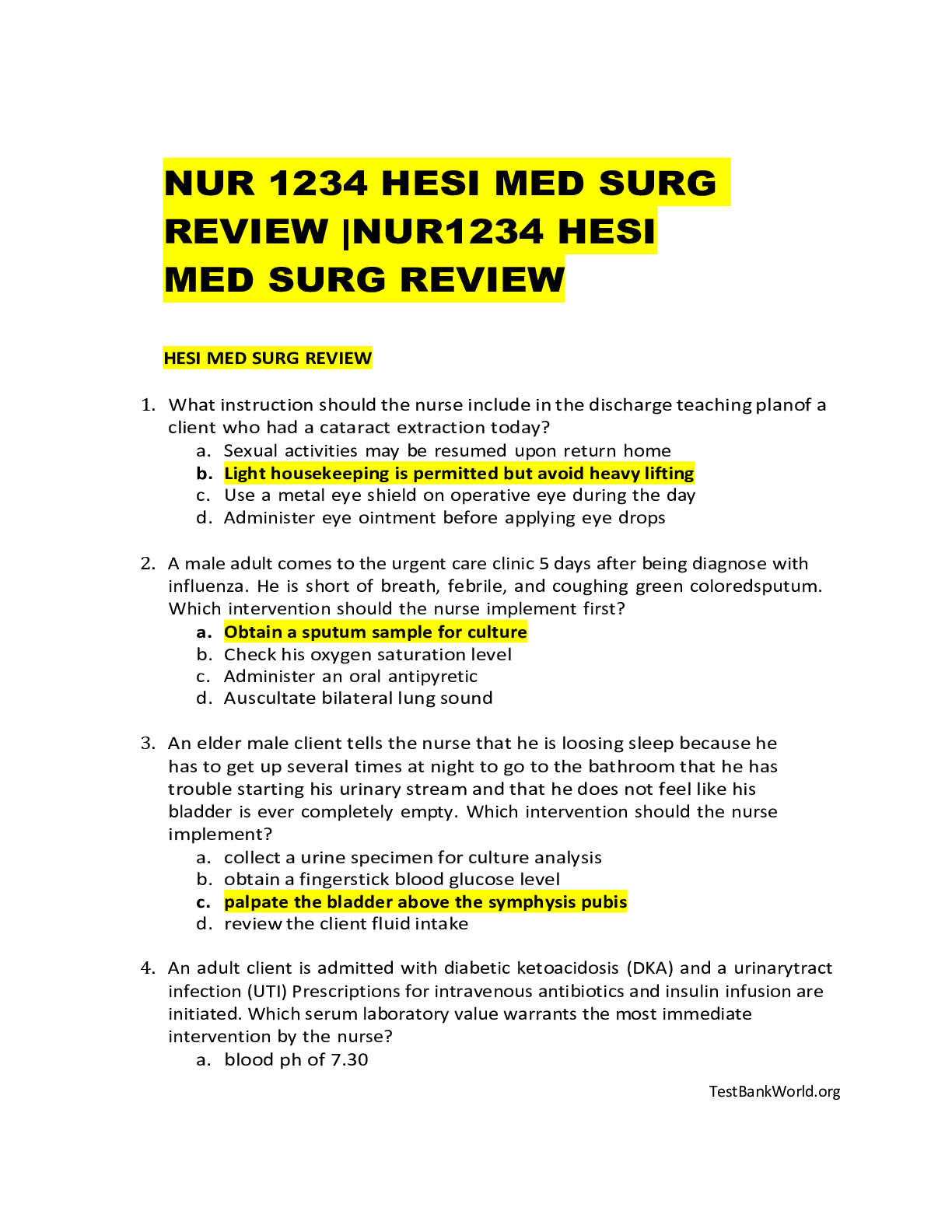
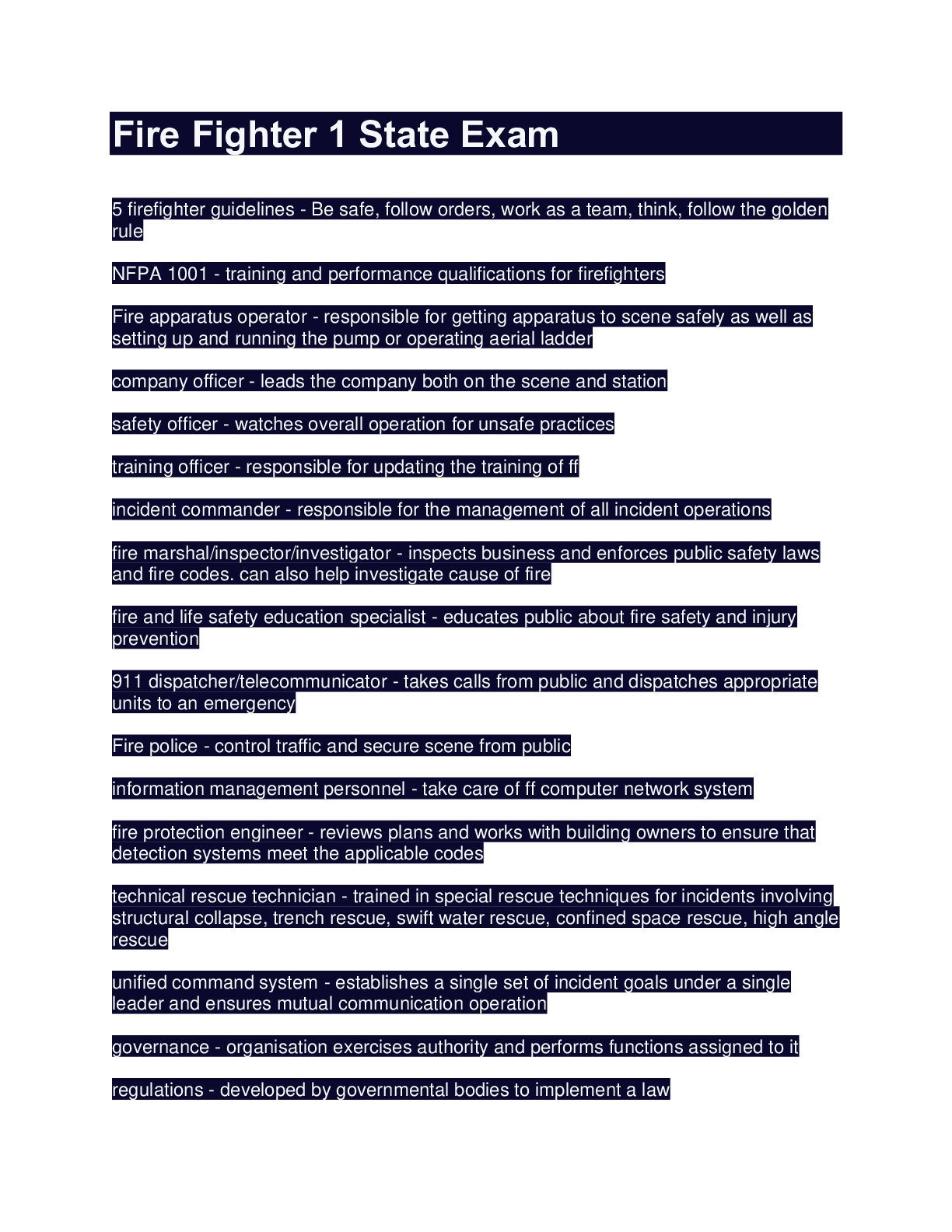

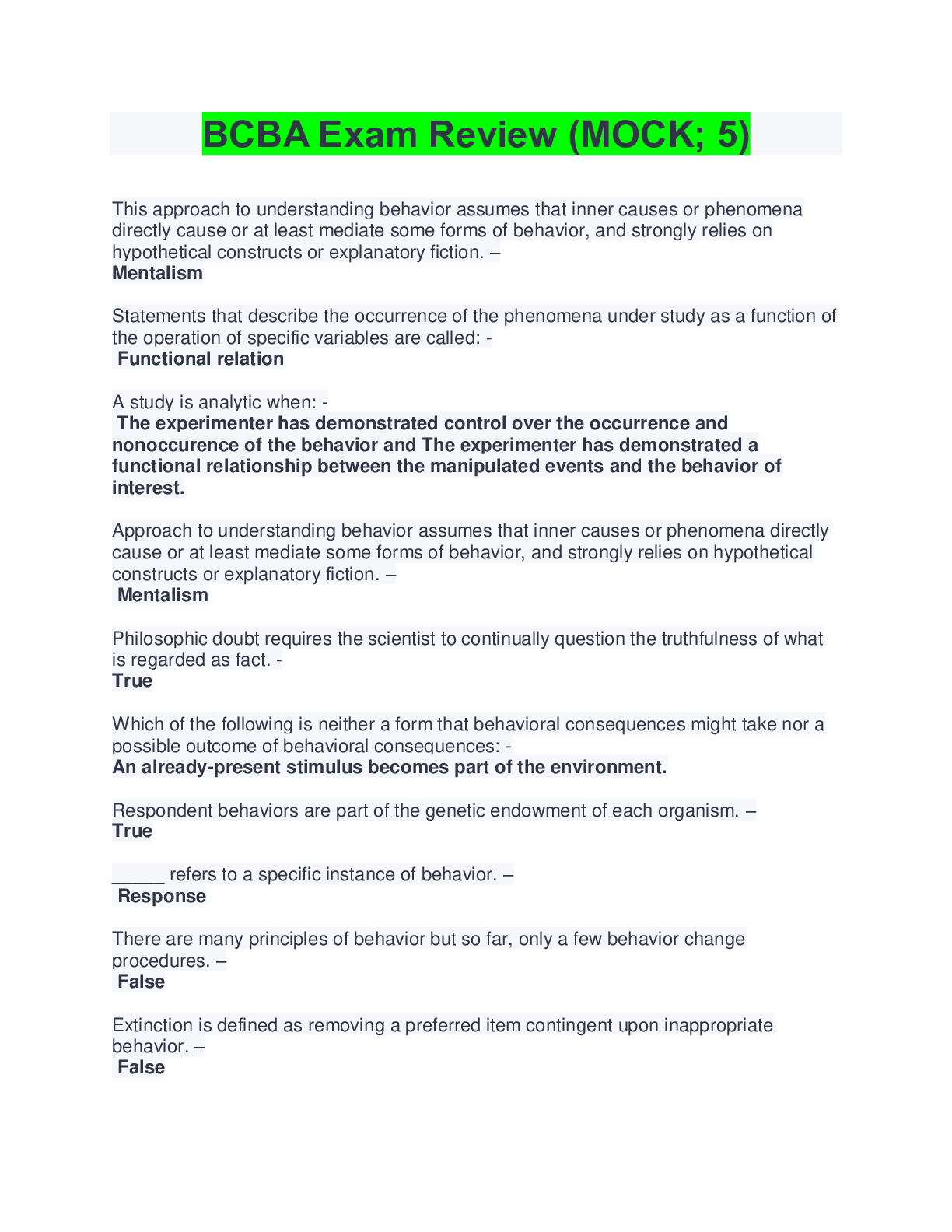

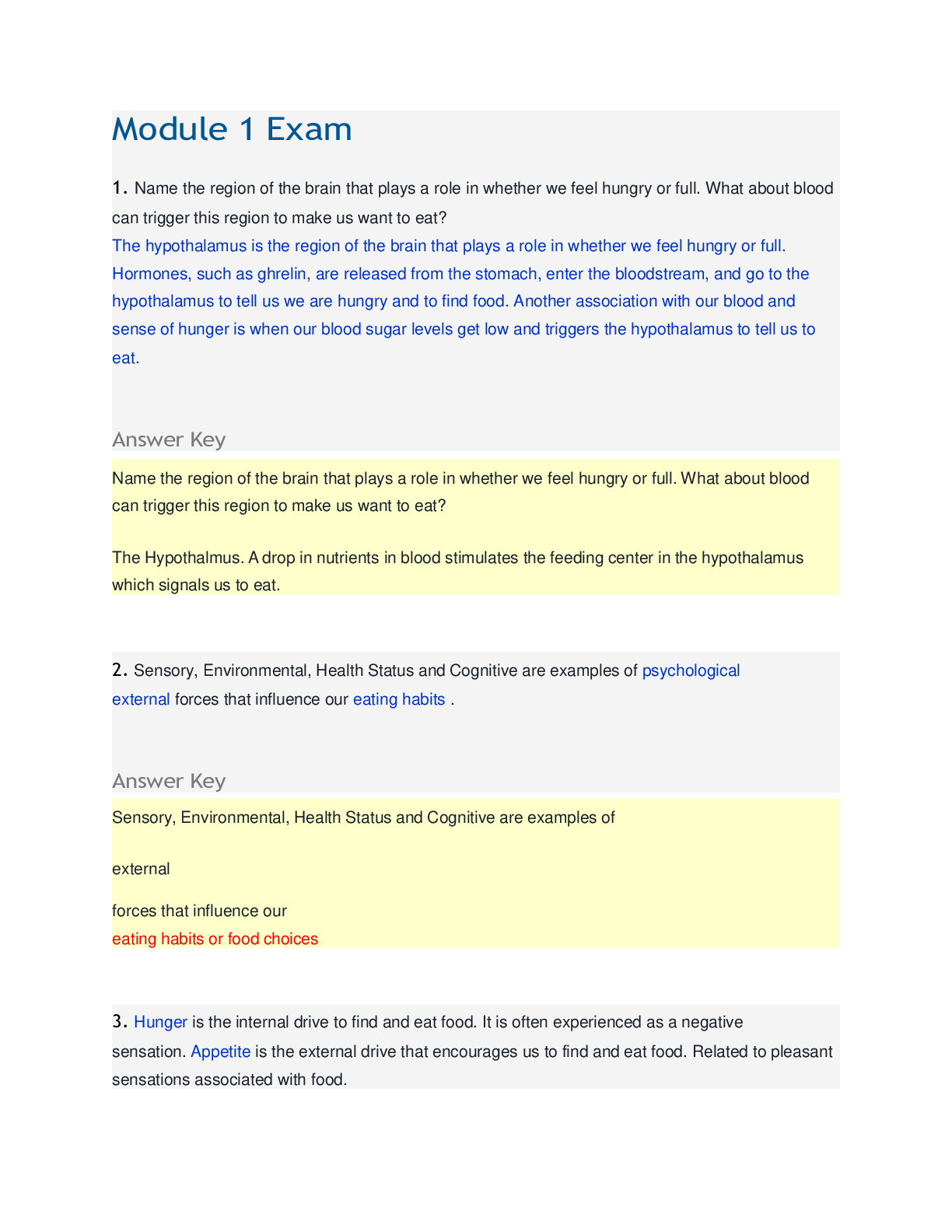
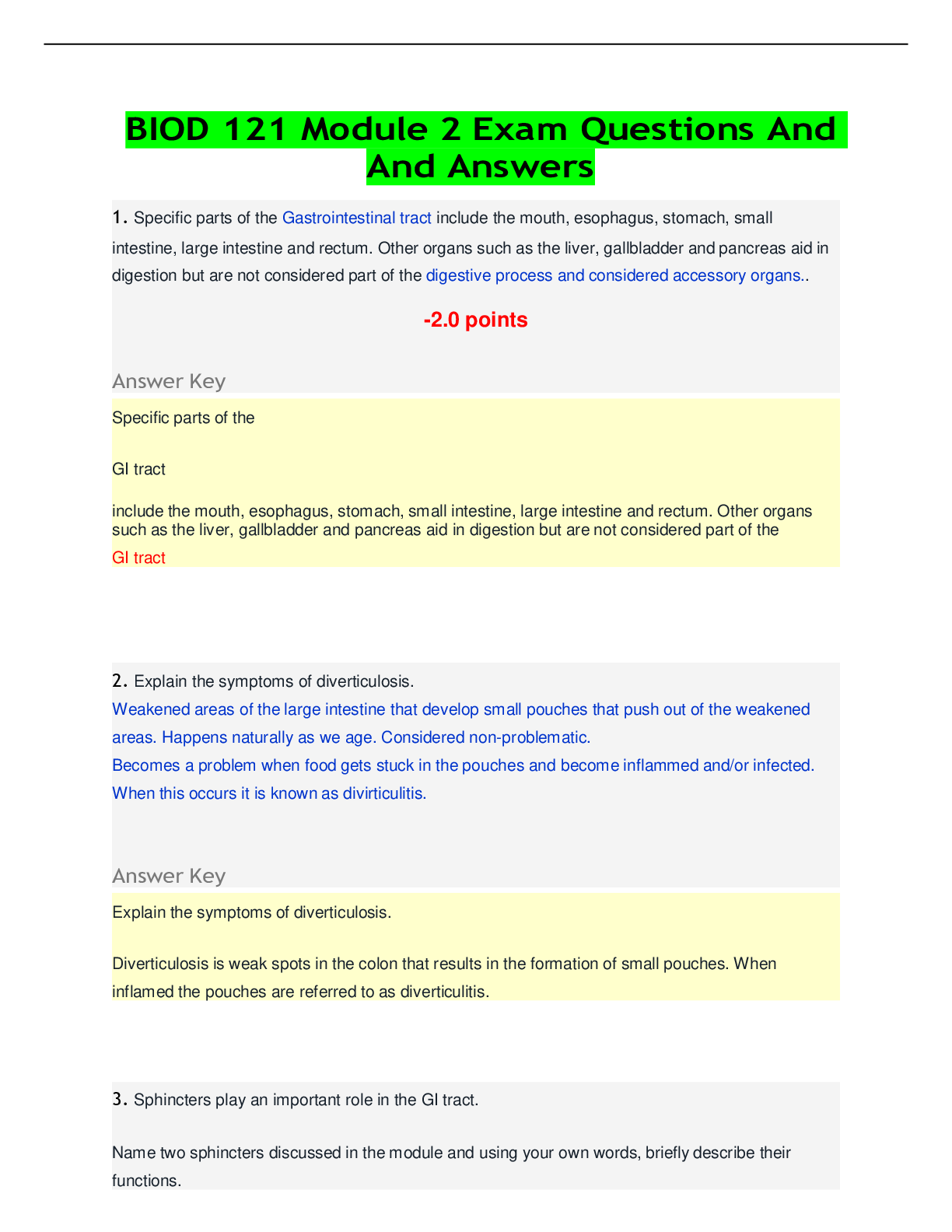
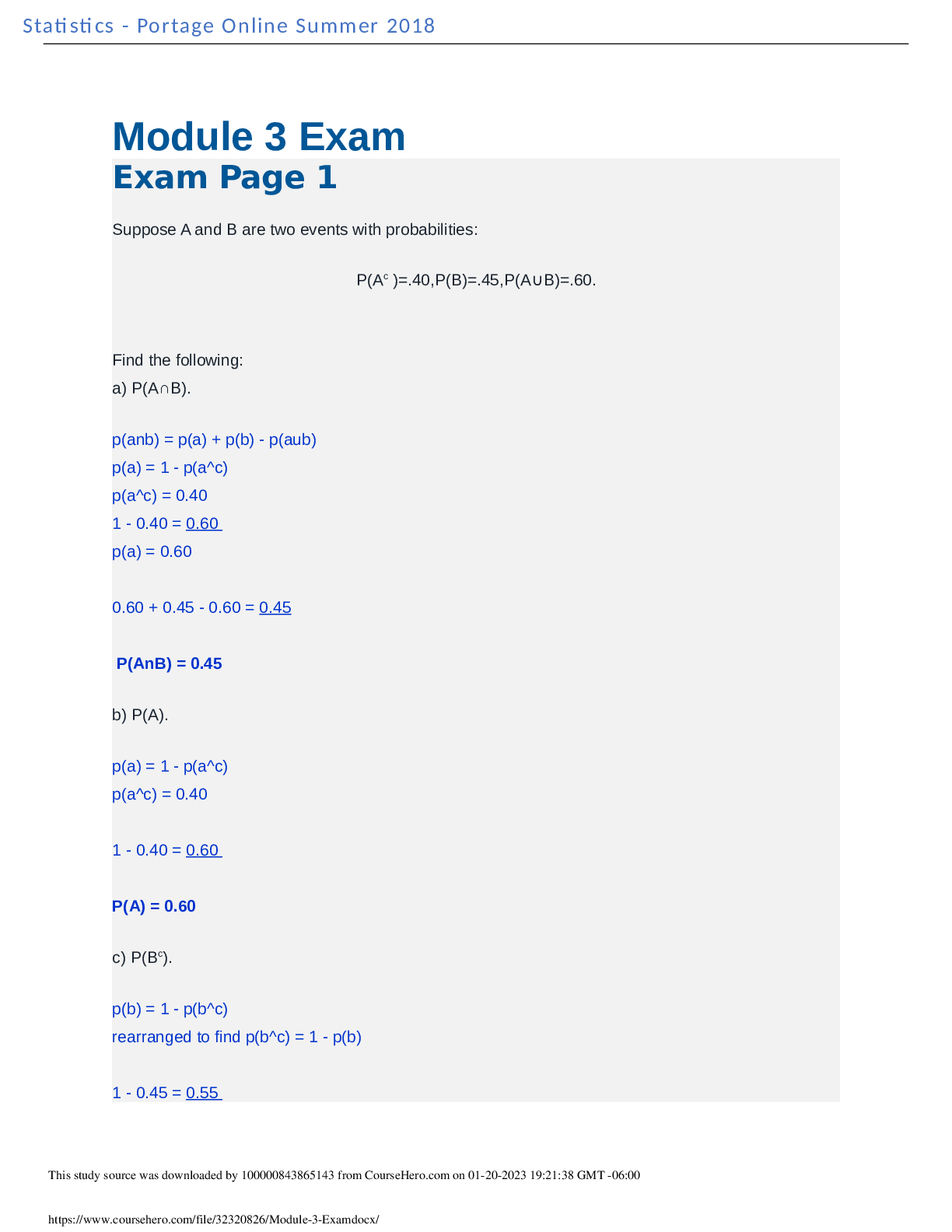

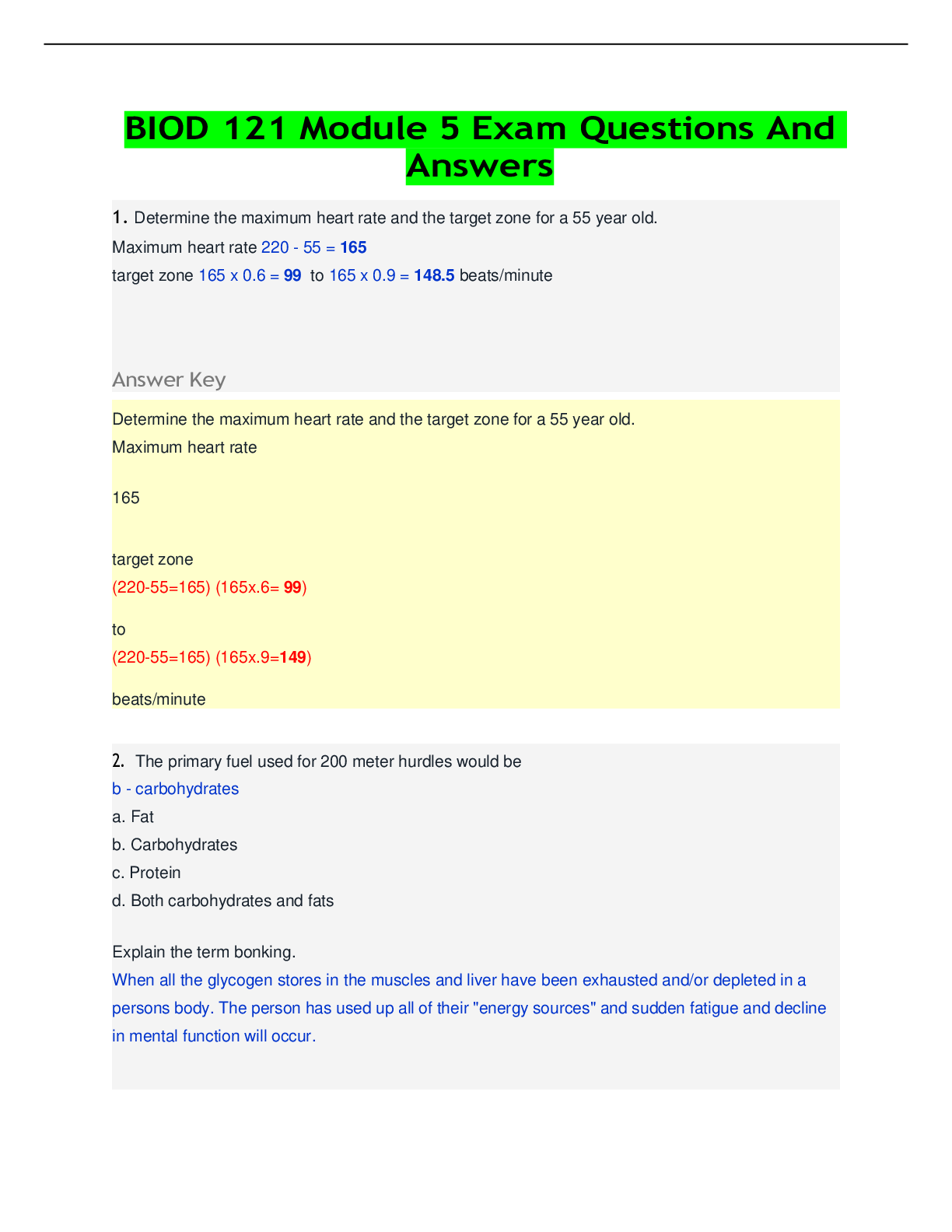

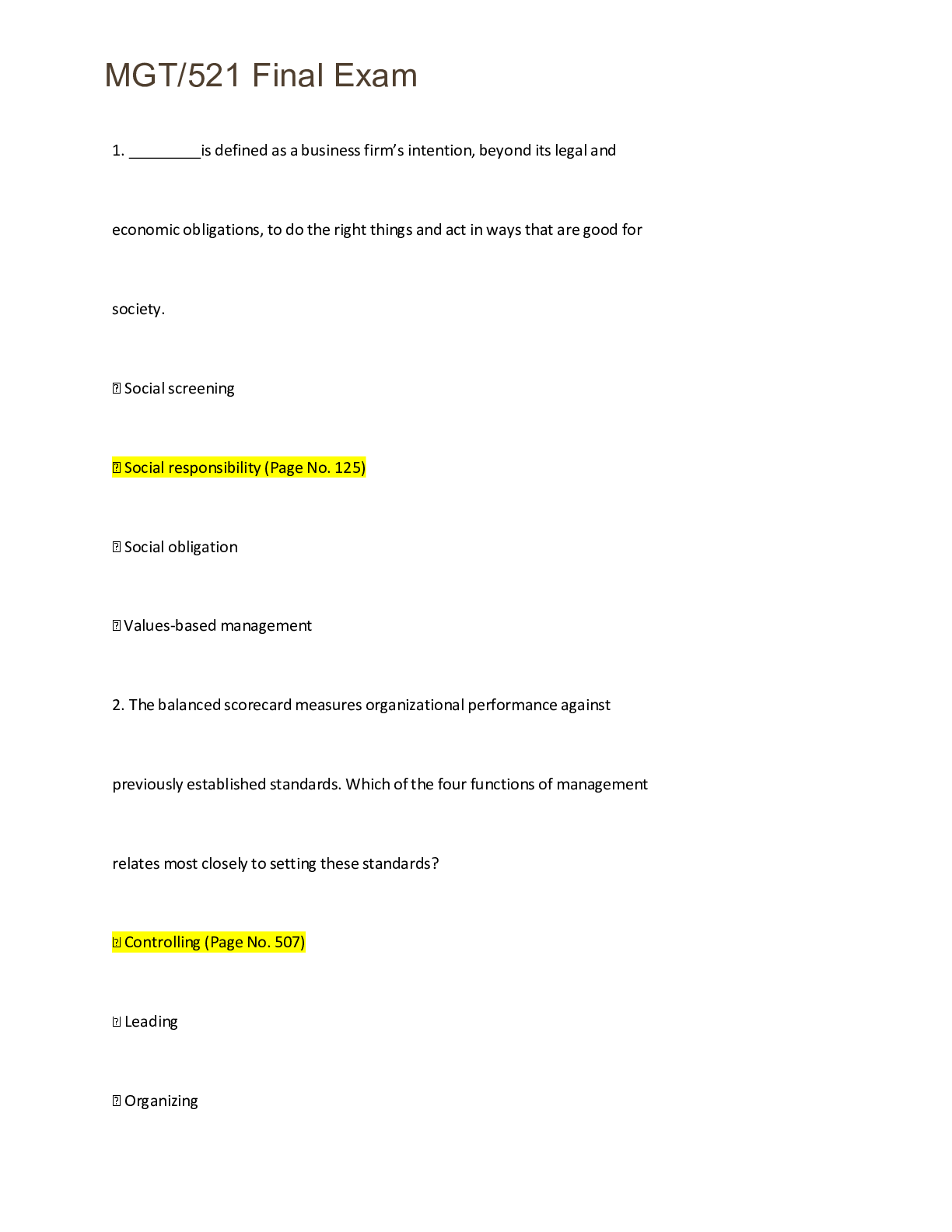

.png)
 (1).png)
